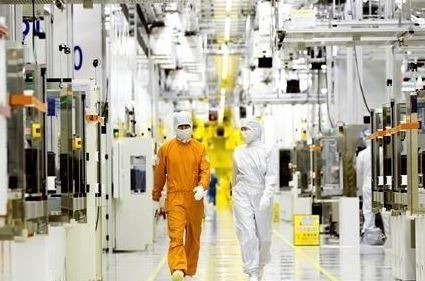The South Korean government projects that the nation’s future industries would require 165,000 workers by 2027, vowing to address skills shortages by training workers through higher education and public projects.
On Tuesday, the Ministry of Trade, Industry and Energy said its survey results revealed a growing need for manpower in five future industries, including next-generation chips, advanced display panels, internet of things-based home appliances, augmented reality and virtual reality technologies and high-tech materials.
 |
(Yonhap) |
According to the survey, there were a total of 109,000 workers in the five industries as of 2017, which lacked some 4,000 employees when compared to minimal demands. By 2027, the demand for human resources in the sectors will rise to 165,000 employees combined, the survey found.
The survey was done by the Korea Institute for Advancement of Technology on managers and executives in charge of research development, technology, production and information technologies of 1,915 companies in the five industries. The survey was conducted twice on December 2017 and June 2018 asking the current number of employees, the number of unfilled jobs and their recruiting plans.
Next-generation chips are chips with markedly improved power consumption or new functions such as artificial intelligence. In the industry, a total of 43,679 employees will be required by 2027, with an annual average growth in demand for manpower of 4.8 percent, the ministry said.
The industry will need more developers and researchers of non-memory chips that can support artificial intelligence and the internet of things.
Advanced display panels are a new form of a display with improved functions in size, resolution and power consumption to provide digital content without limitation. By 2027, the industry will need to hire a total of 21,824 employees with an annual average growth of 4.7 percent.
Jobs will be created mainly in developing next-generation displays such as transparent, foldable and rollable panels and designing a display that can be applied to diverse products and space, according to the government.
IoT-based home appliances provide entertainment and services by integrating IoT technologies into devices used in residential areas. The industry will need to employ a total of 46,744 workers by 2027, with an annual average growth of 4.3 percent.
Promising employment areas in the sector will be developers of IoT-based electronics devices, security specialists that assess the security of IoT products and services, and big data analysts of IoT-based home appliances, the government said.
The AR and VR technology industries will require a combined 9,017 employees while the high-tech new materials industry will need 43,576 employees by 2027, the Industry Ministry said.
“To respond to a growing need for skilled manpower in the future industries, the government will work to foster master’s and doctoral students this year and create new public projects next year,” said Nah Sung-hwa, a chief of the Industry Ministry’s job innovation division.
The ministry set aside 85.1 billion won ($72.9 million) this year to support master and doctoral students in 31 industries, including future mobility, smart factories and robots. It will also push ahead with new public projects in 2020 in 12 areas including next-generation chips, advanced displays, augmented reality and virtual reality.
By Shin Ji-hye (
shinjh@heraldcorp.com)








